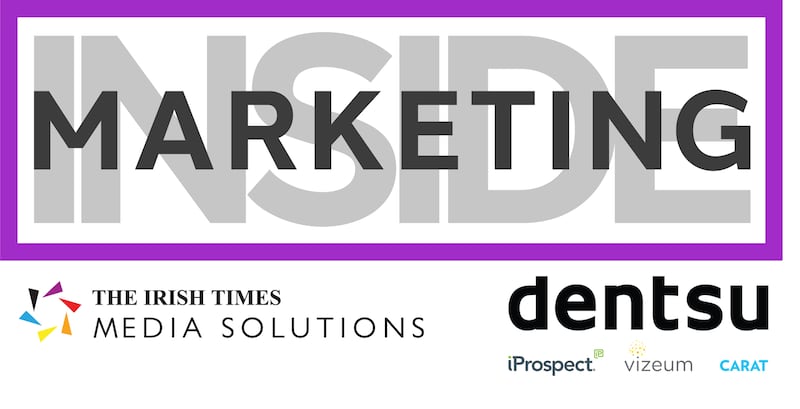Whether you’re running a family shop in Ballinrobe or working for a large multinational in Dublin, the decisions we all take in our businesses and our marketing can influence society around us for the better, or worse. Issues of diversity, inclusion and representation can seem lofty and privileged discussions, but we all have a role to play.
About half a trillion euro is spent on advertising globally each year, and more than double that is spent on the total costs of marketing. That’s billions of messages that reach consumers, and it’s also a huge investment in the content and entertainment that exists around it: the TV shows, websites and viral videos we all love to watch, especially when we can’t leave our homes.
On this week's Inside Marketing podcast, Jerry Daykin, senior media director at GSK, joins us for a discussion around diversity and why it matters for all brands today. Listen now:
Though without deliberate malice, there is a strong unconscious bias that leads a lot of advertising to look rather stereotypical. Small businesses pick generic clip art for their posters, large advertisers make commercials with average, white, middle-class families. While the mother of the family diligently does the housework and waits for the dad to come home from the office, a range of brilliant, diverse characters and stories are left almost invisible. This is improving, but it’s rare to find even casual positive portrayals of different races, sexualities, abilities or even ages, despite the fact we all hope to grow old.
I don’t attempt to overstate the impact of advertising. Much of it is wallpaper for the senses, tomorrow’s chip paper wrappers, or something to mute while you go and make a cup of Barry’s. Yet if you identify with any of those aspects of diversity, you’ll know the familiar feeling that none of those adverts quite reflects your personal reality.
Extraordinary window
Growing up as a gay man in a religious family in the 1990s, it was rare to see anything in the culture around me that suggested the feelings I was experiencing were in anyway normal or acceptable. Living in the UK, it felt like an extraordinary window into another world when I secretly tuned into Channel 4’s Queer as Folk, a show which at the time saw some advertisers back away and refuse to sponsor.
Today I’m part of a voluntary group called Outvertising which encourages more positive portrayals of LGBTQ+ people in the content and advertising around us, but I’m passionate about the steps we can all take to represent a much wider slice of society too.
This isn’t just a call for grand gestures either. Yes, it’s fantastic, and unimaginable a decade ago, that Murphys on Main Street had the Pride flag and a Panti mannequin out to support marriage equality. It’s also been inspiring to see many large corporations making big gestures to stand with the Black Lives Matter movement across the Atlantic. I encourage all companies to keep making such leaps of faith, but the first steps in allyship are much simpler – they’re an ask for consideration and representation in the little decisions we all make.
Take a moment to look at the marketing materials you produce, and even the products themselves you make and sell. Who are you serving and talking to, but who are you not? Not every advert needs to become a box-ticking exercise, but if over the course of the year every person you’ve represented looks and acts exactly like you, are you really talking to your true depth of consumers? We don’t all need to be making crazily progressive adverts, but it is our job as marketers to understand, reflect and communicate to the widest possible audiences.
In digital marketing we've started to take positive steps forward in the field of "brand safety"
Research by the marketing firm Kantar has shown not only that progressive adverts can help you appeal to diverse audiences, but that more mainstream consumers are more likely to pay attention to them and respond to them too. It’s a win-win situation, where better reflecting society in your advertising also makes your advertising more effective. What’s more, research by P&G and Glaad has also shown that mere exposure to such positive portrayals makes people more accepting of diverse family or friends, and more supportive of equal rights.
I work in the media team of a large marketing department, where we decide what to spend those advertising budgets on and where our content should appear. To all those making similar decisions, I ask you to realise that representation doesn’t stop with the content we produce – it extends to where we show that content and what we choose to fund, or not fund.
In digital marketing we’ve started to take positive steps forward in the field of “brand safety”. These are efforts to ensure that in the vastness of the internet we don’t accidentally fund the misinformation and hate speech that is out there. Vital steps that businesses big or small can take, but in doing so we need to be careful not to accidentally block some smaller, diverse voices. Some advertisers have blocked their advertising from words as generic as Muslim or lesbian, and in doing so are defunding any positive journalism and content reflecting these vibrant communities.
Sensitive topic
This year some advertisers asked to avoid all content mentioning Covid-19, which is, of course, a sensitive and emotive topic with some areas you would be wiser to avoid; but at the same time it’s hard to have a conversation, let alone write an article, without mentioning it. Unintentionally we are defunding positive journalism and quality content and sending our money to clickbait websites and “celebrity plastic surgery slide shows” – hardly the premium environments you’d want to show up in.
Once again, we can look for the positives here too. Don’t just ensure you’re not blocking these voices, look for opportunities to advertise deliberately on them or even to partner with them to create content together.
This summer I was proud to see some of our GSK brands partner with Gay Times and Pride Sports.
Together we both casually reshot one of our Sensodyne adverts with more inclusive representation, but also with Voltarol managed to tell the stories of LGBTQ+ sports clubs and how they were keeping people going through the pandemic. We’ve seen great results amplifying that content well beyond the readers of the magazine itself.

If you’re a big advertiser, use your influence to encourage TV stations, newspapers and magazines to cover positively the great diversity around us, and ensure your brand is right alongside it. Find specific titles to partner with, stories to tell or diversity networks representing multiple sites to run across. Work with your agency on creative and media opportunities that will not only make you a genuine and positive champion of these communities but will also make you stand out to everyone else. Search for the Marketer’s Guide to Diversity and Inclusion which we’ve recently published as part of the World Federation of Advertisers for further tips.
If you’re part of a much smaller business, which perhaps doesn’t even think of itself as a marketer at all, there are still small steps to take. Think about how accessible you are to different audiences, the imagery you put in your windows or on your social media, or how you otherwise show your openness. If the pitfalls of digital marketing terrify you, look for training and support from organisations such as the Conscious Advertising Network.
Jerry Daykin is senior media director at GSK Consumer Healthcare
For more information, you can visit irishtimes.com/insidemarketing.
The Inside Marketing podcast is available on Soundcloud.












